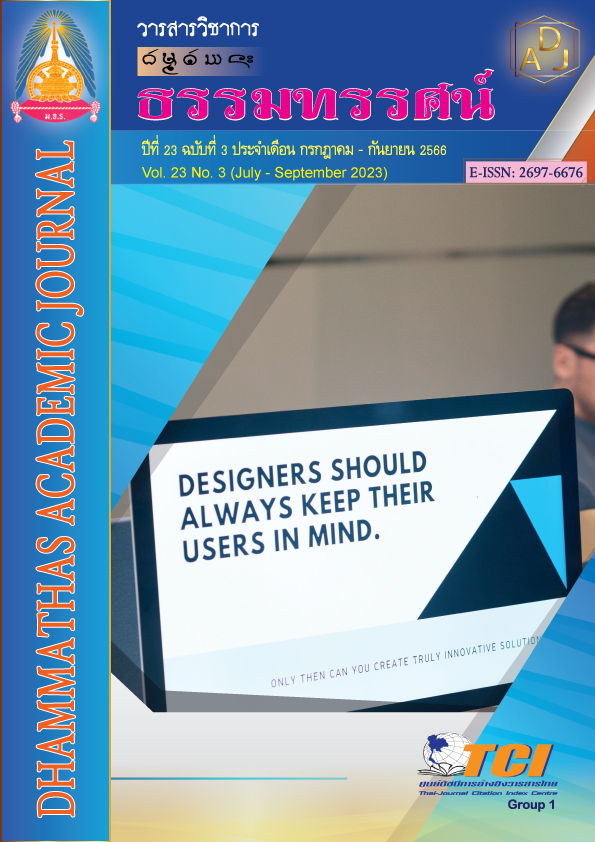The Guidelines for Promoting Happy School Affiliated with Nonthaburi’s Large Secondary School
Main Article Content
Abstract
The purposes of this research were 1) study current conditions, desirable conditions, and happy school needs; and 2) present The Guidelines for Happy Workplace Development of Extra Large Secondary School under the Nonthaburi Secondary Educational Service Area Office. population, namely teachers and educational personnel, the participants were 195. Mixed Method Research The research instrument used includes 5 rating scales and 40 item questionnaires with 8 aspects concerning a happy workplace consisting of Happy body, Happy Heart, Happy Relax, Happy Brain, Happy Soul, Happy Money, Happy Family, and Happy Society. The statistics for analyzing the data were percentage, mean, standard deviation, and Modified Priority Needs Index (PNI modified).
The result showed that:
1. The result showed that the highest PNI modified for Happy Workplace Development of Extra Large Secondary School under the Nonthaburi Secondary Educational Service Area Office was Happy Body (PNI modified = 0.437), followed by Happy Family, Happy Society, Happy Brain, Happy Relax, Happy Money, Happy Heart, and Happy Soul. Need Assessment PNI modified with 0.428, 0.415, 0.386, 0.384, 0.382, 0.345, and 0.311, respectively.
2. The Guidelines for Happy Workplace Development of Extra Large Secondary School under the Nonthaburi Secondary Educational Service Area Office consisted of 35 guidelines: 1. Happy Body (5 guidelines), 2. Happy Heart (4 guidelines), 3. Happy Relax (5 guidelines), 4. Happy Brain (3 guidelines), 5. Happy Soul (4 guidelines), 6. Happy Money (5 guidelines), 7. Happy Family (5 guidelines), and 8. Happy Society (5 guidelines),
respectively.
Article Details

This work is licensed under a Creative Commons Attribution-NonCommercial-NoDerivatives 4.0 International License.
เพื่อให้เป็นไปตามกฎหมายลิขสิทธิ์ ผู้นิพนธ์ทุกท่านต้องลงลายมือชื่อในแบบฟอร์มใบมอบลิขสิทธิ์บทความ ให้แก่วารสารฯ พร้อมกับบทความต้นฉบับที่ได้แก้ไขครั้งสุดท้าย นอกจากนี้ ผู้นิพนธ์ทุกท่านต้องยืนยันว่าบทความ ต้นฉบับที่ส่งมาตีพิมพ์นั้น ได้ส่งมาตีพิมพ์เฉพาะในวารสาร วิชาการธรรม ทรรศน์ เพียงแห่งเดียวเท่านั้น หากมีการใช้ ภาพหรือตารางของผู้นิพนธ์อื่นที่ปรากฏในสิ่งตีพิมพ์อื่นมาแล้ว ผู้นิพนธ์ต้องขออนุญาตเจ้าของลิขสิทธิ์ก่อน พร้อมทั้ง แสดงหนังสือที่ได้รับการยินยอมต่อบรรณาธิการ ก่อนที่บทความจะได้รับการตีพิมพ์References
ชาญวิทย์ วสันต์ธนารัตน์ และธีร์ธรรม วุฑฒิวัตรชัยแก้ว. (2560). องค์กรแห่งความสุข 4.0. กรุงเทพฯ: แอทโฟร์พรินท์.
ณัฐพล น้อยโคตร และบุญชม ศรีสะอาด. (2565). แนวทางการพัฒนาสถานศึกษาสู่องค์กรแห่งความสุข สังกัดสำนักงานเขตพื้นที่การศึกษาประถมศึกษามหาสารคาม เขต 2. (วิทยานิพนธ์การศึกษามหาบัณฑิต). มหาสารคาม: มหาวิทยาลัยมหาสารคาม.
พระมหาวุฒิชัย วชิรเมธี. (2550). คนสำราญ งานสำเร็จ. (พิมพ์ครั้งที่ 3). กรุงเทพฯ: อมรินทร์พิ้นติ้งแอนด์พลับลิชชิ่ง.
พัชรพรรณ เวียงเกา. (2561). ความสัมพันธ์ระหว่างภาวะผู้นำการเปลี่ยนแปลงของหัวหน้าหอผู้ป่วยกับการเป็นองค์กรแห่งความสุข กลุ่มการพยาบาลโรงพยาบาลแพร่. (วิทยานิพนธ์พยาบาลศาสตรมหาบัณฑิต). พิษณุโลก: มหาวิทยาลัยนเรศวร.
พิกุล พุ่มช้าง และปริญญา มีสุข. (2562). การวิเคราะห์องค์ประกอบการเป็นองค์กรแห่งความสุขของสถาบันการศึกษาไทย. Veridian E-Journal, Silpakorn University, 10(2), 647-663.
ภัทรพล สายแวว และต้องลักษณ์ บุญธรรม. (2565). ความต้องการจำเป็นของการส่งเสริมความเป็นองค์กรแห่งความสุขของสถานศึกษา สังกัดสำนักงานเขตพื้นที่การศึกษามัธยมศึกษาปทุมธานี. การประชุมวิชาการนำเสนอผลงานวิจัยระดับชาติ ครั้งที่ 4 Graduate School Conference 2022 iHappiness : ความสุขและคุณภาพชีวิตที่ดีอย่างยั่งยืนในยุคสังคมดิจิทัล, 31 สิงหาคม 2565, (หน้า 1474-1481). สมุทรสงคราม: มหาวิทยาลัยราชภัฏสวนสุนันทา วิทยาเขตสมุทรสงคราม.
ศราวุฒิ อินดา และวันทนา อมตาริยกุล. (2565). แนวทางการพัฒนาสู่องค์กรแห่งความสุขของสถานศึกษา สังกัดสำนักงานเขตพื้นที่การศึกษาประถมศึกษาจังหวัดหนองคาย. วารสารปัญญาปณิธาน, 7(1), 84-96.
สำนักงานกองทุนสนับสนุนการสร้างเสริมสุขภาพ. (2552). สู่องค์กรความสุข ยุควิกฤตคิดสร้างสรรค์ จัดการแบบมีทางเลือก. เข้าถึงได้จาก http://www.thaihealth.or.th/node/11713
สุวิมล ว่องวาณิช. (2558). การวิจัยประเมินความต้องการจำเป็น. (พิมพ์ครั้งที่ 3). กรุงเทพฯ: จุฬาลงกรณ์มหาวิทยาลัย.
Happy Workplace Center. (2017). 1 2 3 Make a Happier Workplace. Retrieved form https://www.linkedin.com/pulse/1-2-3-make-happier-workplace-part-individuals-robert
Murray, R. B. and Zentner, J. P. (1993). Nursing assessment and health promotion strategies through the life span. (4th ed.). U.S.A.: Appleton & Lange.
World Health Organization. (1993). WHOQOL: Study Protocol: Division of Mental Health. Geneva: World Health Organization.

